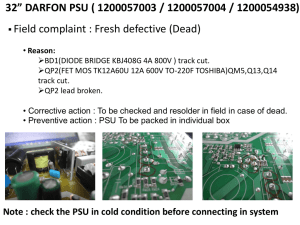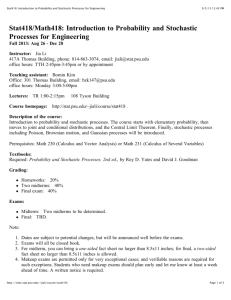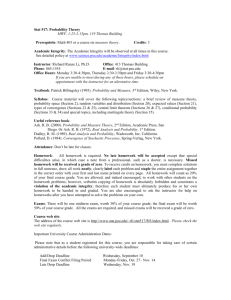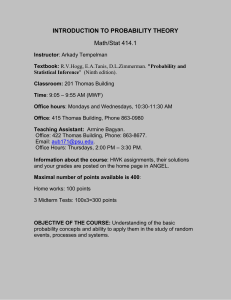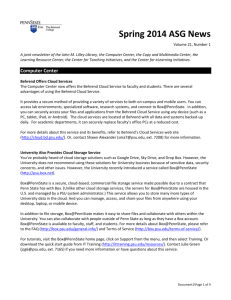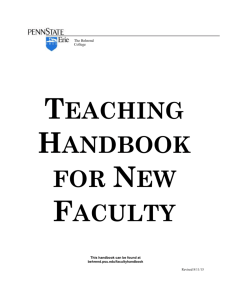Syllabus for STAT463: Applied Time Series Analysis
advertisement
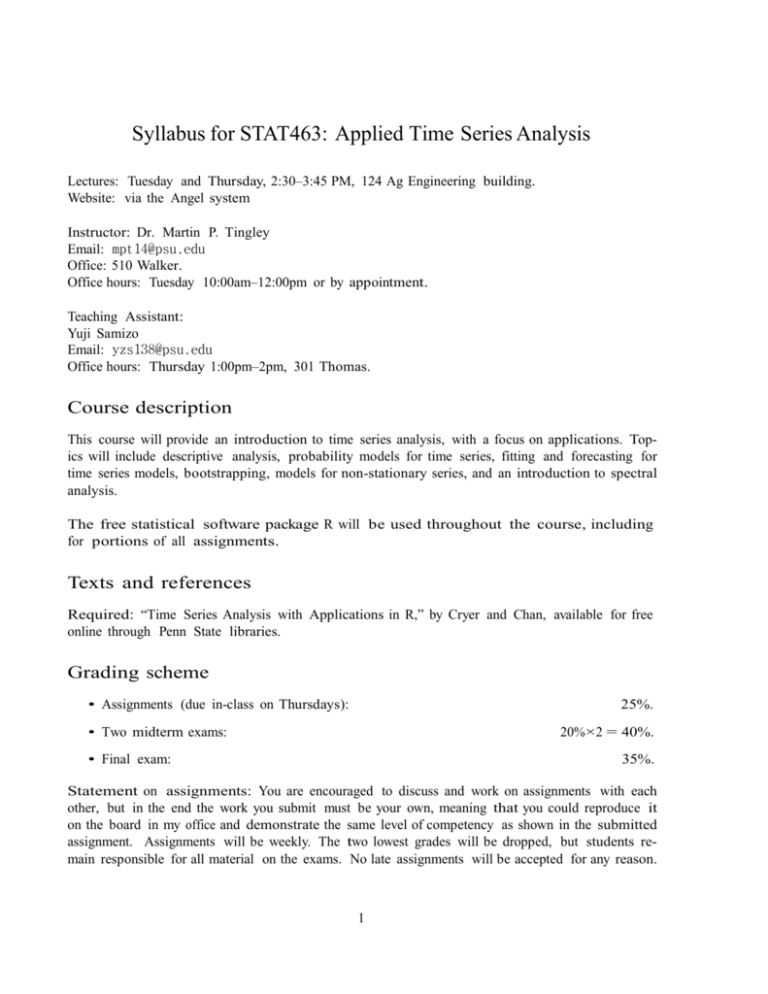
Syllabus for STAT463: Applied Time Series Analysis Lectures: Tuesday and Thursday, 2:30–3:45 PM, 124 Ag Engineering building. Website: via the Angel system Instructor: Dr. Martin P. Tingley Email: mpt14@psu.edu Office: 510 Walker. Office hours: Tuesday 10:00am–12:00pm or by appointment. Teaching Assistant: Yuji Samizo Email: yzs138@psu.edu Office hours: Thursday 1:00pm–2pm, 301 Thomas. Course description This course will provide an introduction to time series analysis, with a focus on applications. Topics will include descriptive analysis, probability models for time series, fitting and forecasting for time series models, bootstrapping, models for non-stationary series, and an introduction to spectral analysis. The free statistical software package R will be used throughout the course, including for portions of all assignments. Texts and references Required: “Time Series Analysis with Applications in R,” by Cryer and Chan, available for free online through Penn State libraries. Grading scheme • Assignments (due in-class on Thursdays): 25%. • Two midterm exams: 20%×2 = 40%. • Final exam: 35%. Statement on assignments: You are encouraged to discuss and work on assignments with each other, but in the end the work you submit must be your own, meaning that you could reproduce it on the board in my office and demonstrate the same level of competency as shown in the submitted assignment. Assignments will be weekly. The two lowest grades will be dropped, but students remain responsible for all material on the exams. No late assignments will be accepted for any reason. 1 Statement on exams: Exams will be closed book: no notes, no textbook, no calculators. All required formulae will be provided. For parity with the other section of STAT463, exams will be 50 minutes in length. The two sections of STAT463 will feature similar midterms, though the questions will differ. The midterms will be designed to be taken in 50 minutes. Course outline, sub ject to revision Numbers refer to chapters in C&C. • Week 1: Introduction and fundamentals (1–2) • Week 2: Basics of R. Trends (3). • Week 3: Models for stationary time series (4) • Week 4: Models for stationary (4) and non stationary (5) time series. • Week 5: Model Specification (6). Midterm 1, covering C&C Chapters 1–5, in class on Thursday 12 February. HW due on Wednesday. • Week 6: Model Specification continued (6). Parameter Estimation (7). No HW. • Week 7: Parameter Estimation continued (7). Model Diagnostics (8). • Week 8: Forecasting from ARIMA models (9). • Spring recess • Week 9: Forecasting from ARIMA models continued (9). Bootstrapping: parameter estimation and forecasting (7.6+). • Week 10: Overflow or review. Midterm 2, covering C&C Chapters 1–9, in class on Thursday 26 March. HW due on Wednesday. • Week 11: Seasonal models (10). No HW. • Week 12: Time series regression models (11). • Week 13: ARCH and GARCH models (12). • Week 14: Introduction to spectral analysis (13). • Week 15: Estimation for spectral analysis (14). 2 STAT 463 Learning Ob jectives Upon successful completion of this course, students are expected to understand 1. the important graphical features of a time series, including seasonal and non-seasonal trends 2. the distinction between independent and correlated data and how correlated errors complicate the assumptions of the usual regression model 3. the properties of stationarity, including the definitions of autocovariance and autocorrelation 4. how to difference time series data to remove seasonal and non-seasonal trends 5. the properties of ARMA models, including the distinction between autoregressive and moving average components 6. how to estimate the parameters for ARMA models and how to choose among several candidate models based on diagnostic techniques 7. how to use estimated time series models to predict unknown observations ahead in time 8. use R software to perform EDA, model fitting, model diagnostics, forecasting and simulation for time series 9. use and interpret R software output from time series modeling exercises, in combination with theoretical understanding of time series modeling, to gain practical insights into the structure of real-world time series 3 Mandatory and strongly recommended syllabus items as per official university policy Course policies with regards attendance: This course abides by the Penn State Class Attendance policies. Students who miss class for legitimate reasons will be given a reasonable opportunity to make up missed work, including exams and quizzes. Students are not required to secure the signature of medical personnel in the case of illness or injury and should use their best judgment on whether they are well enough to attend class or not; the University Health Center will not provide medical verification for minor illnesses or injuries. Other legitimate reasons for missing class include religious observance, family emergencies, and regularly scheduled universityapproved curricular or extracurricular activities. Students who encounter serious family, health, or personal situations that result in extended absences should contact the Office of Student and Family Services for help: http: //studentaffairs.psu.edu/familyservices/. Whenever possible, students participating in University-approved activities should submit to the instructor a Class Absence Form, available at www.psu.edu/oue/aappm/classabs.pdf, at least one week prior to the activity. More information is available at: http://senate.psu.edu/policies/42-00.html#42-27 http://www.psu.edu/oue/aappm/E-11.html http://www.psu.edu/ufs/policies/44-00.html#44-35 http://studentaffairs.psu.edu/health/welcome/illnessVerification/ http://www.psu.edu/oue/aappm/R-4.html Academic integrity statement: Academic integrity is the pursuit of scholarly activity in an open, honest and responsible manner. Academic integrity is a basic guiding principle for all academic activity in the College. All students should act with personal integrity, respect other students’ dignity, rights and property, and help create and maintain an environment in which all can succeed through the fruits of their efforts. Students in this class are expected to write up their problem sets individually, to work the exams on their own, and to write any papers in their own words using proper citations. Class members may work on problem sets in groups, but each student must write up their answers separately. Students are not to copy problem or exam answers from another person’s paper and present them as their own; students may not plagiarize text from papers or websites written by others. Students who present other people’s work as their own will receive at least a 0 on the assignment and may well receive an F or XF in the course. For information about the Earth and Mineral Sciences Academic Integrity Policy, which this course adopts, please see: http://www.ems.psu.edu/current_undergrad_students/academics/ integrity_policy. Accommodations for students with disabilities: Penn State welcomes students with disabilities into the University’s educational programs. Every Penn State campus has an office for students with disabilities. The Office for Disability Services (ODS) Web site provides contact information for every Penn State campus: http://equity.psu.edu/ods/dcl. For further information, please visit the Office for Disability Services Web site:http://equity.psu.edu/ods. In order to receive consideration for reasonable accommodations, you must contact the appropriate disability services office at the campus where you are officially enrolled, participate in an intake interview, and provide documentation: http://equity.psu.edu/ods/guidelines. If the documentation supports your request for reasonable accommodations, your campuss disability services office will provide you with an accommodation letter. Please share this letter with your instructors and discuss the accommodations with them as early in your courses as possible. You must follow this process for every semester that you request accommodations. Statement on campus emergencies, including weather delays: Campus emergencies, including weather delays, are announced on Penn State News (http:/news.psu.edu/) and communicated to cellphones, email, the Penn State Facebook page, and Twitter via PSUTXT (to sign up, please see http://psutxt.psu.edu). Disclaimer Statement: The specifics of this Course Syllabus may be changed at any time, and you will be responsible for abiding by any such changes. Changes will be posted on the course website. 4
